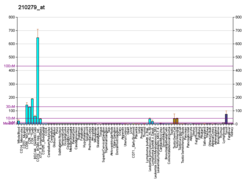N-Arachidonyl glycine receptor (NAGly receptor), also known as G protein-coupled receptor 18 (GPR18), is a protein that in humans is encoded by the GPR18 gene. [5] [6] Along with the other previously orphan receptors GPR55 and GPR119, GPR18 has been found to be a receptor for endogenous lipid neurotransmitters, several of which also bind to cannabinoid receptors. [7] [8] [9] It has been found to be involved in the regulation of intraocular pressure. [10]
Contents
Research supports the hypothesis that GPR18 is the abnormal cannabidiol receptor and N-arachidonoyl glycine, the endogenous lipid metabolite of anandamide, initiates directed microglial migration in the CNS through activation of GPR18, [11] though recent evidence demonstrates that NAGly was not shown to be a GPR18 agonist in rat sympathetic neurons. [12]
Resolvin D2 (RvD2), a member of the specialized proresolving mediators (SPM) class of polyunsaturated fatty acid metabolites, is an activating ligand for GPR18; RvD2 and its activation of GPR18 contribute to the resolution of inflammatory responses as well as inflammation-based and other diseases in animal models and are proposed to do so in humans. [13] Furthermore, RvD2 is a metabolite of the omega-3 fatty acid, docosahexaenoic acid (DHA); the metabolism of DHA to RvD2 and RvD2's activation of GPR18 is proposed to one among many other mechanisms for the anti-inflammatory and other beneficial effects attributed to omega-3 fatty acid-rich diets [14]




